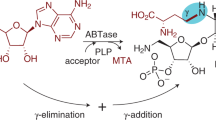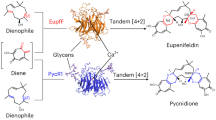Abstract
The tunicamycins are archetypal nucleoside antibiotics targeting bacterial peptidoglycan biosynthesis and eukaryotic protein N-glycosylation. Understanding the biosynthesis of their unusual carbon framework may lead to variants with improved selectivity. Here, we demonstrate in vitro recapitulation of key sugar-manipulating enzymes from this pathway. TunA is found to exhibit unusual regioselectivity in the reduction of a key α,β-unsaturated ketone. The product of this reaction is shown to be the preferred substrate for TunF—an epimerase that converts the glucose derivative to a galactose. In Streptomyces strains in which another gene (tunB) is deleted, the biosynthesis is shown to stall at this exo-glycal product. These investigations confirm the combined TunA/F activity and delineate the ordering of events in the metabolic pathway. This is the first time these surprising exo-glycal intermediates have been seen in biology. They suggest that construction of the aminodialdose core of tunicamycin exploits their enol ether motif in a mode of C–C bond formation not previously observed in nature, to create an 11-carbon chain.
This is a preview of subscription content, access via your institution
Access options
Subscribe to this journal
Receive 12 print issues and online access
$259.00 per year
only $21.58 per issue
Buy this article
- Purchase on Springer Link
- Instant access to full article PDF
Prices may be subject to local taxes which are calculated during checkout






Similar content being viewed by others
References
Brandish, P. E. et al. Modes of action of tunicamycin, liposidomycin B, and mureidomycin A: inhibition of phospho-N-acetylmuramyl-pentapeptide translocase from Escherichia coli. Antimicrob. Agents Chemother. 40, 1640–1644 (1996).
Heifetz, A., Keenan, R. W. & Elbein, A. D. Mechanism of action of tunicamycin on the UDP-GlcNAc:dolichyl-phosphate GlcNAc-1-phosphate transferase. Biochemistry 18, 2186–2192 (1979).
Tamura, G. Tunicamycin (Japan Scientific Societies Press, 1982).
Hamill, R. L., Hoehn, M. H. & Boeck, L. D. Process for preparing tunicamycin. US patent 4,336,333 (1980).
Takatsuki, A., Arima, K. & Tamura, G. Tunicamycin, a new antibiotic: 1. Isolation and characterization of tunicamycin. J. Antibiot. 24, 215–223 (1971).
Takatsuki, A. et al. Structural elucidation of tunicamycin: 2. Structure of tunicamycin. Agric. Biol. Chem. 41, 2307–2309 (1977).
Tsvetanova, B. C. & Price, N. P. J. Liquid chromatography-electrospray mass spectrometry of tunicamycin-type antibiotics. Anal. Biochem. 289, 147–156 (2001).
Thrum, H. et al. Streptovirudins, new antibiotics with antibacterial and antiviral activity: 1. Culture taxonomy, fermentation and production of streptovirudin complex. J. Antibiot. 28, 514–521 (1975).
Vogel, P. et al. Isolation of a group of glycolipid toxins from seedheads of annual ryegrass (Lolium rigidum Gaud.) infected by Corynebacterium rathayi. Austr. J. Exp. Biol. Med. Sci. 59, 455–467 (1981).
Kenig, M. & Reading, C. Holomycin and an antibiotic (MM 19290) related to tunicamycin, metabolites of Streptomyces clavuligerus. J. Antibiot. 32, 549–554 (1979).
Nakamura, S., Arai, M., Karasawa, K. & Yonehara, H. On an antibiotic, mycospocidin. J. Antibiot. 10, 248–253 (1957).
Mizuno, M., Shimojima, Y., Sugawara, T. & Takeda, I. Antibiotic 24010. J. Antibiot. 24, 896–899 (1971).
Tamura, G., Sasaki, T., Matsuhashi, M., Takatsuki, A. & Yamasaki, M. Tunicamycin inhibits formation of lipid intermediate in cell-free peptidoglycan synthesis of bacteria. Agric. Biol. Chem. 40, 447–449 (1976).
Walsh, C. Where will new antibiotics come from? Nature Rev. Microbiol. 1, 65–70 (2003).
Xu, L., Appell, M., Kennedy, S., Momany Frank, A. & Price Neil, P. J. Conformational analysis of chirally deuterated tunicamycin as an active site probe of UDP-N-acetylhexosamine:polyprenol-P N-acetylhexosamine-1-P translocases. Biochemistry 43, 13248–13255 (2004).
Elbein, A. D. The tunicamycins — useful tools for studies on glycoproteins. Trends Biochem. Sci. 6, 219–221 (1981).
Danishefsky, S. J., Deninno, S. L., Chen, S., Boisvert, L. & Barbachyn, M. Fully synthetic stereoselective routes to the differentially protected subunits of the tunicamycins. J. Am. Chem. Soc. 111, 5810–5818 (1989).
Ichikawa, S. & Matsuda, A. Synthesis of tunicaminyluracil derivatives. Nucleosides Nucleotides Nucleic Acids 23, 239–253 (2004).
Karpiesiuk, W. & Banaszek, A. Stereoselective syntheses of the O,N-protected subunits of the tunicamycins. Carbohydr. Res. 299, 245–252 (1997).
Ramza, J. & Zamojski, A. New convenient synthesis of tunicamine. Tetrahedron 48, 6123–6134 (1992).
Myers, A. G., Gin, D. Y. & Rogers, D. H. Synthetic studies of the tunicamycin antibiotics. Preparation of (+)-tunicaminyluracil, (+)-tunicamycin-V, and 5′-epi-Tunicamycin-V. J. Am. Chem. Soc. 116, 4697–4718 (1994).
Suami, T., Sasai, H., Matsuno, K. & Suzuki, N. Synthetic approaches toward antibiotic tunicamycins. Part VIII. Total synthesis of tunicamycin. Carbohydr. Res. 143, 85–96 (1985).
Tsvetanova, B. C., Kiemle, D. J. & Price, N. P. J. Biosynthesis of tunicamycin and metabolic origin of the 11-carbon dialdose sugar, tunicamine. J. Biol. Chem. 277, 35289–35296 (2002).
Wyszynski, F. J., Hesketh, A. R., Bibb, M. J. & Davis, B. G. Dissecting tunicamycin biosynthesis by genome mining: cloning and heterologous expression of a minimal gene cluster. Chem. Sci. 1, 581–589 (2010).
Chen, W. et al. Characterization of the tunicamycin gene cluster unveiling unique steps involved in its biosynthesis. Prot. Cell 1, 1093–1105 (2010).
Karki, S., Kwon, S-Y. & Kwon, H-J. Cloning of tunicamycin biosynthetic gene cluster from Streptomyces chartreusis NRRL 3882. J. Kor. Soc. Appl. Biol. Chem. 54, 136–140 (2011).
Berman, H., Henrick, K. & Nakamura, H. Announcing the worldwide Protein Data Bank. Nature Struct. Biol. 10, 980–980 (2003).
Allard, S. T. M. et al. Toward a structural understanding of the dehydratase mechanism. Structure 10, 81–92 (2002).
Allard, S. T. M., Cleland, W. W. & Holden, H. M. High resolution X-ray structure of dTDP-glucose 4,6-dehydratase from Streptomyces venezuelae. J. Biol. Chem. 279, 2211–2220 (2004).
Demendi, M., Ishiyama, N., Lam, J. S., Berghuis, A. M. & Creuzenet, C. Towards a better understanding of the substrate specificity of the UDP-N-acetylglucosamine C4 epimerase WbpP. Biochem. J. 389, 173–180 (2005).
Kowal, P. & Wang, P. G. New UDP-GlcNAc C4 epimerase involved in the biosynthesis of 2-acetamino-2-deoxy-L-altruronic acid in the O-antigen repeating units of Plesiomonas shigelloides O17. Biochemistry 41, 15410–15414 (2002).
Jornvall, H. et al. Short-chain dehydrogenases reductases (SDR). Biochemistry 34, 6003–6013 (1995).
Filling, C. et al. Critical residues for structure and catalysis in short-chain dehydrogenases/reductases. J. Biol. Chem. 277, 25677–25684 (2002).
Schulz, J. M. et al. Determinants of function and substrate specificity in human UDP-galactose 4′-epimerase. J. Biol. Chem. 279, 32796–32803 (2004).
Creuzenet, C., Belanger, M., Wakarchuk, W. W. & Lam, J. S. Expression, purifcation, and biochemical characterization of WbpP, a new UDP-GlcNAc C4 epimerase from Pseudomonas aeruginosa serotype O6. J. Biol. Chem. 275, 19060–19067 (2000).
Gross, J. W., Hegeman, A. D., Vestling, M. M. & Frey, P. A. Characterization of enzymatic processes by rapid mix-quench mass spectrometry: the case of dTDP-glucose 4,6-dehydratase. Biochemistry 39, 13633–13640 (2000).
Allard, S. T. M. et al. The crystal structure of dTDP-D-glucose 4,6-dehydratase (RmlB) from Salmonella enterica serovar Typhimurium, the second enzyme in the dTDP-L-rhamnose pathway. J. Mol. Biol. 307, 283–295 (2001).
Gust, B. et al. Lambda red-mediated genetic manipulation of antibiotic-producing Streptomyces. Adv. Appl. Microbiol. 54, 107–128 (2004).
Kieser, T., Bibb, M. J., Buttner, M. J., Chater, K. F. & Hopwood, D. A. Practical Streptomyces Genetics (The John Innes Foundation, 2000).
Kaysser, L. et al. Identification and manipulation of the caprazamycin gene cluster lead to new simplified liponucleoside antibiotics and give insights into the biosynthetic pathway. J. Biol. Chem. 284, 14987–14996 (2009).
Kaysser, L., Siebenberg, S., Kammerer, B. & Gust, B. Analysis of the liposidomycin gene cluster leads to the identification of new caprazamycin derivatives. ChemBioChem 11, 191–196 (2010).
Rackham, E. J., Gruschow, S., Ragab, A. E., Dickens, S. & Goss, R. J. M. Pacidamycin biosynthesis: identification and heterologous expression of the first uridyl peptide antibiotic gene cluster. ChemBioChem 11, 1700–1709 (2010).
Marsh, E. N. G., Patterson, D. P. & Li, L. Adenosyl radical: reagent and catalyst in enzyme reactions. ChemBioChem 11, 604–621 (2010).
Giese, B. The stereoselectivity of intermolecular free radical reactions. Angew. Chem. Int. Ed. Engl. 28, 969–980 (1989).
Giese, B. & Dupuis, J. Anomeric effect of radicals. Tetrahedron Lett. 25, 1349–1352 (1984).
Kahne, D., Yang, D., Lim, J. J., Miller, R. & Paguaga, E. The use of alkoxy-substituted anomeric radicals for the construction of beta-glycosides. J. Am. Chem. Soc. 110, 8716–8717 (1988).
Crich, D. & Lim, L. B. L. Synthesis of 2-deoxy-β-C-pyranosides by diastereoselective hydrogen-atom transfer. Tetrahedron Lett. 31, 1897–1900 (1990).
Cipolla, L., Liguori, L., Nicotra, F., Torri, G. & Vismara, E. Glycomimetics via a new glycoexoenitols-malonyl radical C–C bond formation. Chem. Commun. 1253–1254 (1996).
Vauzeilles, B. & Sinay, P. Selective radical synthesis of β-C-disaccharides. Tetrahedron Lett. 42, 7269–7272 (2001).
Sambrook, J. & Russell, D. Molecular Cloning: A Laboratory Manual (Cold Spring Harbor Laboratory Press, 2000).
Otwinowski, Z. & Minor, W. Processing of X-ray diffraction data collected in oscillation mode. Methods Enzymol. 276, 307–326 (1997).
Adams, P. D. et al. PHENIX: a comprehensive Python-based system for macromolecular structure solution. Acta Crystallogr. D 66, 213–221 (2010).
Emsley, P. & Cowtan, K. COOT: model-building tools for molecular graphics. Acta Crystallogr. D 60, 2126–2132 (2004).
Emsley, P., Lohkamp, B., Scott, W. G. & Cowtan, K. Features and development of COOT. Acta Crystallogr. D 66, 486–501 (2010).
Gregory, M. A., Till, R. & Smith, M. C. M. Integration site for Streptomyces phage BT1 and development of site-specific integrating vectors. J. Bacteriol. 185, 5320–5323 (2003).
Chen, W. et al. Characterization of the polyoxin biosynthetic gene cluster from Streptomyces cacaoi and engineered production of polyoxin H. J. Biol. Chem. 284, 10627–10638 (2009).
Ginj, C., Ruegger, H., Amrhein, N. & Macheroux, P. 3′-Enolpyruvyl-UMP, a novel and unexpected metabolite in nikkomycin biosynthesis. ChemBioChem 6, 1974–1976 (2005).
Acknowledgements
The authors gratefully acknowledge B. Odell (Oxford University) for help with the NMR experiments. This work was supported by the EPSRC (DTA studentship for F.J.W.), the Bill and Melinda Gates Foundation (S.S.L.) and BBSRC (J.P.G-E. and M.J.B). G.J.D and B.G.D. are Royal Society Wolfson Research Merit Award recipients. This manuscript is dedicated to the memory of Professor David Gin.
Author information
Authors and Affiliations
Contributions
F.J.W. cloned tunF, purified the protein and performed functional and kinetic analyses of TunF. S.S.L. and T.Y. cloned tunA and its mutants, purified the resulting proteins and performed functional analyses. S.S.L. performed the kinetic analyses. TunA was crystallized by T.Y. The 3D structure was determined by S.J.L., and S.S.L., B.G.D and G.J.D. carried out its analysis. H.W. and J.P.G-E. created the tunB mutant strain and extracts. M.J.B. designed the deletion strategy. H.W., M.J.B. and B.G.D. analysed the extracts. The manuscript was written by F.J.W., S.S.L., M.J.B., G.J.D. and B.G.D.
Corresponding author
Ethics declarations
Competing interests
The University of Oxford has filed a patent, in which the authors are named as inventors, on the utility of the biosynthetic cluster and enzymes derived from it.
Supplementary information
Supplementary information
Supplementary information (PDF 3610 kb)
Rights and permissions
About this article
Cite this article
Wyszynski, F., Lee, S., Yabe, T. et al. Biosynthesis of the tunicamycin antibiotics proceeds via unique exo-glycal intermediates. Nature Chem 4, 539–546 (2012). https://doi.org/10.1038/nchem.1351
Received:
Accepted:
Published:
Issue Date:
DOI: https://doi.org/10.1038/nchem.1351
This article is cited by
-
Draft genome sequence of Streptomyces sp. KD18, isolated from industrial soil
3 Biotech (2023)
-
Biosynthesis of the nucleoside antibiotic angustmycins: identification and characterization of the biosynthetic gene cluster reveal unprecedented dehydratase required for exo-glycal formation
The Journal of Antibiotics (2021)
-
The regulation of ferroptosis by MESH1 through the activation of the integrative stress response
Cell Death & Disease (2021)
-
Efficient biosynthesis of nucleoside cytokinin angustmycin A containing an unusual sugar system
Nature Communications (2021)
-
Engineering of Streptomyces lividans for heterologous expression of secondary metabolite gene clusters
Microbial Cell Factories (2020)



